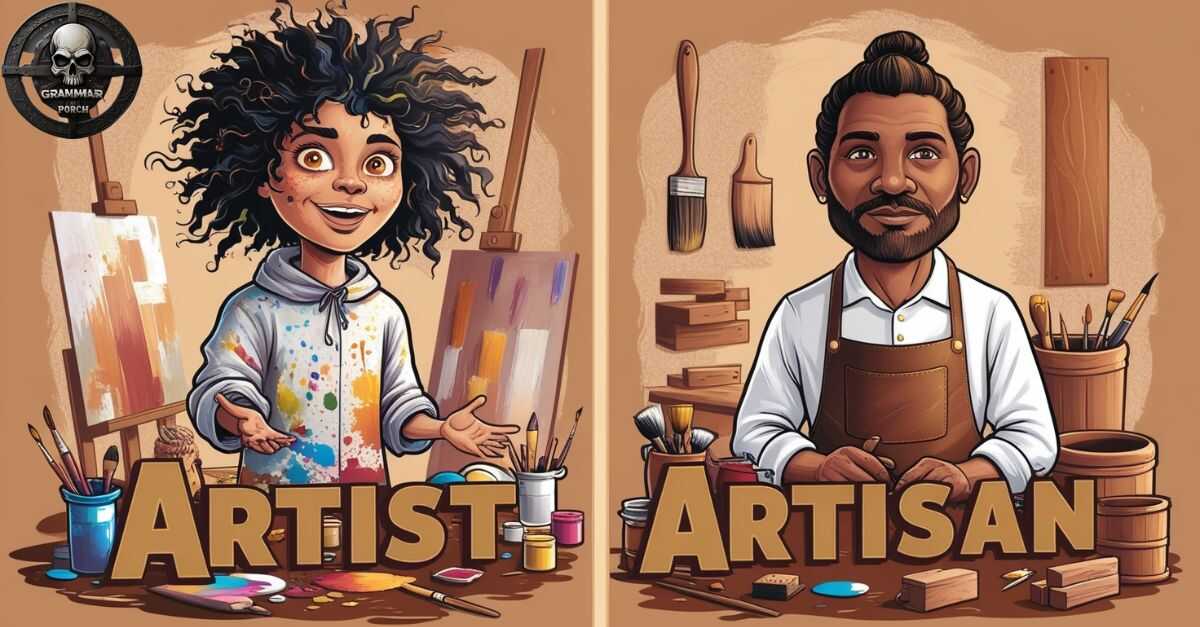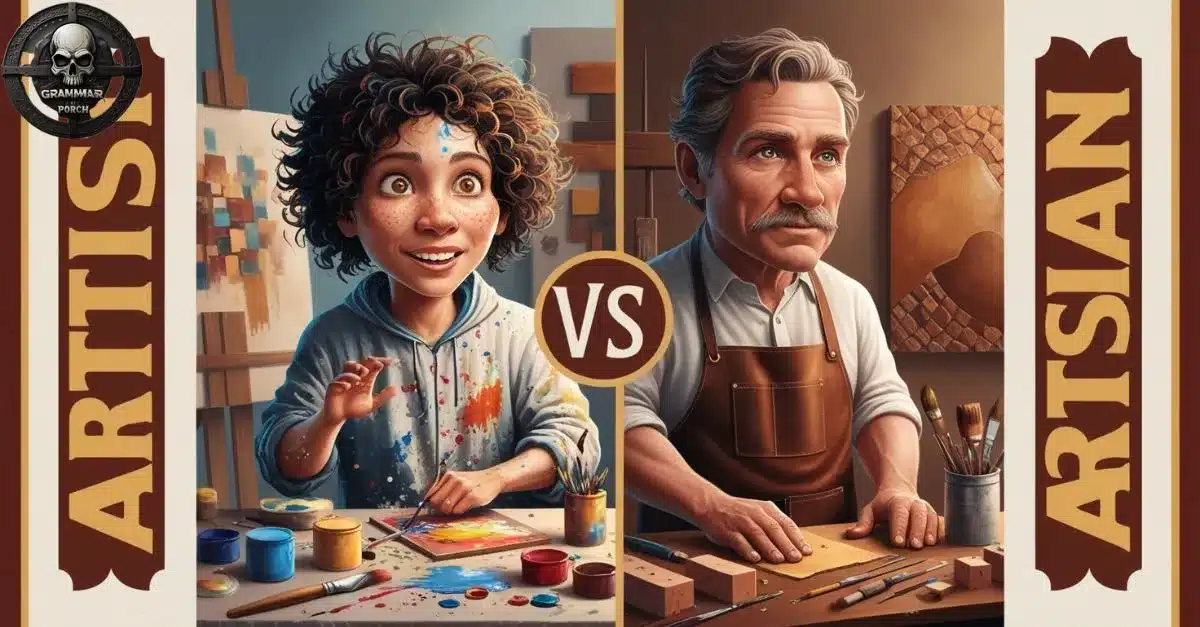The terms artist vs artisan are often confused, but they have distinct meanings. Artists focus on self-expression and creating unique, emotional works that challenge norms. In contrast, artisans use traditional skills to craft functional items that are both beautiful and practical.
While both contribute significantly to the world of art and craftsmanship, the key difference lies in their focus, process, and the materials they use. Artists typically explore abstract ideas, while artisans prioritize mastery of techniques and utility. Both bring valuable and unique contributions to their fields.
Who is an Artist?

An artist is someone driven by creative imagination and self-expression. They may work with a variety of materials like clay, paint, or digital mediums, aiming to evoke emotions and reactions from their audience.
Art isn’t always practical; its value often lies in its ability to make us feel or think in new ways. Whether it’s painting, sculpture, or fine art forms, an artist’s work is a reflection of personal vision and creative freedom.
Is word “artist” correct?
The term “artist” has evolved over time. It traces back to the Renaissance humanism period when artistic prestige was highly valued.
Today, an artist refers to anyone engaging in artistic pursuits and those whose work focuses on creativity, expression and innovation, rather than practicality.
Definition
The dictionary defines an artist as “a person engaged in creating visual art, music, or other forms of creative work.” The word often implies that their work is about self-expression, emotional depth, and conceptual ideas.
Meaning
The meaning of “artist” goes beyond just creating; it’s about making something with a deep sense of personal vision. An artist works not just to make something beautiful but to tell a story, challenge norms, or push the boundaries of what we consider art. The focus is on emotional engagement and unique style, which sets an artist’s work apart.
Who is an Artisan?

An artisan is a craftsman who focuses on making functional objects using traditional skills. They have a hands-on approach to creating items like pottery, furniture, or jewelry.
The value of an artisan’s work comes from its utility and the mastery of techniques passed down through generations. Their creations, though beautiful, serve a practical purpose in everyday life.
Is the word Artisan correct?
The term “artisan” accurately describes someone who makes handcrafted items. It refers to those who practice heritage techniques and methods rooted in historical tradition. Artisanal skills are often learned through apprenticeships, where hands-on experience is key.
Definition
An artisan is “a worker in a skilled trade, especially one that involves making things by hand.” Unlike an artist, an artisan’s goal is to create something that serves a practical purpose, blending beauty with functionality.
Meaning
The meaning of “artisan” emphasizes craftsmanship over creativity. The focus is on quality, skill, and the work ethic needed to perfect a craft. Artisans aim for consistency and expertise in their chosen field, whether it’s woodworking, metalwork, or ceramics. Their work may be visually appealing, but its function and utility are equally important.
Quick Summary
In simple terms, an artist works with creative imagination, while an artisan works with skilled craftsmanship. Artists tend to focus on expression and innovation, whereas artisans create practical, functional art rooted in traditional skills.
| Aspect | Artist | Artisan |
| Focus | Expression, Emotion | Craftsmanship, Function |
| Process | Abstract, Conceptual | Practical, Hands-on |
| Materials | Varies (e.g., paint, clay) | Specific (e.g., wood, metal) |
| End Product | Fine Art | Functional Objects |
Pronunciation of Artist vs Artisan
The pronunciation of “artist” is simple: ahr-tist. For “artisan,” the correct way is ahr-tuh-zuhn, with a softer sound. Both terms are used as nouns in English.
Parts of Speech
Both artist and artisan are nouns. “Artist” refers to a person who creates art, while “artisan” refers to a person who makes handcrafted items. Both can be pluralized by adding an “s” (artists, artisans).
What are the Similarities between Artist vs Artisan?
While artists and artisans differ in focus, they share some common traits. Both value creativity, expertise, and a dedication to their craft. Both artists and artisans take pride in their work, often spending years perfecting their skills and creating a signature look.
Side-by-Side Comparison: Artist vs Artisan

Focus
Artists focus on creativity and imaginative work, while artisans emphasize practicality and functionality. An artist may be driven by emotion or concept, while an artisan is more focused on utility and technique.
Process
Artists usually follow a free-flowing process driven by new ideas and expression, whereas artisans rely on specific methods and expertise that have been refined over time.
Uniqueness
While both roles value originality, artists are known for their distinctiveness and often have a more visionary approach. Artisans, however, are celebrated for their mastery of traditional skills and the precision they bring to their work.
Materials
Artists experiment with various materials, including digital media, clay, and paints. Artisans, however, often work with specific substances like wood, metal, or ceramics, focusing on what’s practical for their creations.
Is an Artist also an Artisan?
Yes, an artist can be an artisan. There are many cases where the two roles overlap, especially in functional art where artistic vision and practical craftsmanship meet.
Which One is More Acceptable?
Neither term is more acceptable than the other; it depends on the context. In the fine art world, artistic prestige is often given to artists. However, artisans are highly respected for their work ethic and contribution to preserving traditional craftsmanship.
Origins of “Artist” vs “Artisan”

“Artist”
The word “artist” comes from Latin, rooted in Renaissance philosophy. During this period, artists were seen as intellectuals and creators of culture. The idea of the modern artist emerged with Renaissance humanism, where individual creativity was highly valued.
“Artisan”
The word “artisan” stems from the Italian word “artigiano,” which means craftsman. Historically, artisans were highly skilled workers who mastered specific trades like blacksmithing, carpentry, and ceramics. Artisanal skills have been passed down through generations and continue to hold significance today.
Synonyms of “Artist” vs “Artisan”
Artist:
- Creator
- Visual artist
- Sculptor
- Painter
- Visionary
- Illustrator
- Designer
- Fine artist
- Performer
- Conceptual artist
Artisan:
- Craftsman
- Maker
- Creator
- Handicraftsman
- Craftsperson
- Skilled worker
- Tradesman
- Handcrafter
- Craft worker
- Journeyman
“Artist” and “Artisan” Examples

Artist in Sentences:
- Pablo Picasso revolutionized modern art with his groundbreaking cubist paintings.
- Vincent van Gogh is best known for his vibrant and emotional works like Starry Night.
- Andy Warhol used pop culture in his art, creating iconic images like the Campbell’s Soup Cans.
- Frida Kahlo expressed her pain and identity through surreal self-portraits.
- Leonardo da Vinci painted The Last Supper, one of the most studied works in art history.
- Michelangelo sculpted the famous statue of David, a symbol of Renaissance humanism.
- Georgia O’Keeffe was known for her large-scale flower paintings and depictions of the American Southwest.
- Jean-Michel Basquiat combined street art with fine art, exploring social and political issues.
- Jackson Pollock developed a unique drip painting technique that changed abstract expressionism.
- Salvador Dalí created surreal and bizarre imagery, such as the melting clocks in The Persistence of Memory.
Artisan in Sentences:
- Sam Maloof crafted beautiful, functional wooden furniture that became collector’s items.
- Celia Pym is a skilled textile artist who specializes in mending and preserving worn fabrics.
- Bill Amberg is a leather artisan known for his handcrafted luxury bags and accessories.
- Svend Bayer creates stunning ceramic pieces using traditional firing techniques.
- Bill Carter is a talented jeweler who designs intricate, one-of-a-kind silver jewelry.
- Lauren van Zoonen uses traditional glassblowing techniques to make elegant glassware.
- Alfred Waterhouse was a famous Victorian architect who blended artistic vision with functional designs.
- Koichi Takada is a furniture artisan known for his minimalist yet highly detailed pieces.
- Kawai Kanjiro was a renowned Japanese potter who revived traditional pottery techniques.
- Jim Henson, although best known for his work in television, was also a puppet-making artisan whose creations became cultural icons.
FAQs
Can a person be both an artist and an artisan?
Yes, it’s common for people to balance both artistry and craftsmanship.
How do I know if I am an artist or an artisan?
It depends on whether you focus more on creativity or practical craftsmanship.
What is the importance of artisans in today’s world?
Artisans preserve traditional skills and create high-quality handcrafted goods.
Is digital art considered an artisanal craft?
No, digital art is typically seen as part of modern artistry, though it may require
technical skill.
Can an artisan work in a large-scale production industry?
Yes, but the term “artisan” often refers to those who practice handcrafted or small-batch work.
Conclusion
Artists and artisans both contribute to the creative world, they do so in different ways. Artists focus on emotional expression, abstract ideas, and challenging societal norms through their work. Artisans, however, prioritize skilled craftsmanship and functionality, creating practical yet aesthetically pleasing objects.
The key difference lies in their approach—artists emphasize creativity and unique style, while artisans focus on mastery of techniques and practicality. Both roles are essential, enriching our world through their distinct forms of artistic and functional creativity.

Larry is an experienced blogger with a passion for simplifying grammar. With years of expertise in writing and language, he shares insightful tips on punctuation, synonyms, and the intricacies of English grammar at **Grammar Porch**. His approachable style helps readers improve their writing skills with ease.

